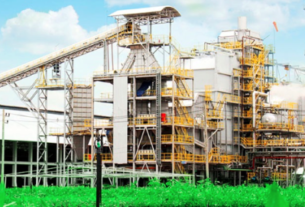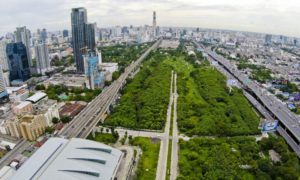
An aerial view of the State Railway of Thailand’s undeveloped Makkasan plot in downtown Bangkok
Thai state railway to open golden empty lands
Proposed new holding company aims to lease vast tracts of land for development in congested downtown Bangkok
The State Railway of Thailand’s (SRT) headquarters, a gem of century-old Siamese architecture tucked behind central Bangkok’s Hua Lamphong railway station, may soon be converted into a boutique hotel.
“It’s very quiet here at night,” Voravuth Mala, SRT’s deputy governor in charge of property management, said of the old office, a three-story building with wide wooden staircases, parquet floors, tall windows, broken air conditioners and no elevators. “If we put in more lights, it will be safe.”
What to do with the SRT’s old headquarters is just one of the many property plans sitting on Voravuth’s desk, which was notably stacked with papers and reports during a recent interview.
Founded by King Chulalongkorn (Rama V) in 1890, the SRT is now one of the kingdom’s biggest property holders, with an estimated land bank of 200,000 rai (32,000 hectares) nationwide.
An estimated 40,000 rai (6,400 hectares) of those holdings have been classified as “non-core” land, i.e. unused for “core activities” such as railway activities.
While land-rich, the SRT is cash poor and heavily indebted, to the tune of an estimated 200 billion baht (US$6.4 billion) at the end of fiscal year 2016/17, ending on September 30, 2017.
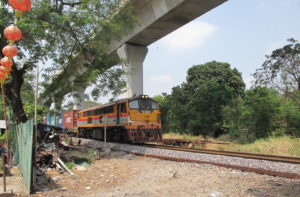
Thai train on a track in downtown Bangkok in February 2018. Photo: Peter Janssen
Last year’s estimated operating loss, before interest and depreciation, was 5.4 billion baht (US$170 million), ranking the SRT among Thailand’s worst performing state owned enterprises (SOEs).
Shortly after the May 2014 coup, the SRT was grouped with six other financially challenged SOEs and tasked by soldier politicians with devising a debt rehabilitation plan as part of the military regime’s broad effort to reform the SOE sector. There are now 56 SOEs in Thailand.
At a meeting on January 19, coup-installed Prime Minister General Prayuth Chan-ocha approved in principle the SRT’s rehabilitation proposal, the crux of which entails the establishment of a separate company to handle its vast property holdings, much of which sit in prime locations in Bangkok.
The Cabinet must also approve the plan before the new holding company can be established, though SRT officials are optimistic it could be established by the end of this year. The State Enterprise Policy Office (SEPO), the key agency handling SOE reform, is upbeat about the plan.
“Even though the SRT faces difficulties, there is some hope because of the assets they have,” said Ekniti Nitithanprapas, SEPO’s director-general. He estimates the SRT can “do something” commercial with nearly 40,000 rai it holds that is currently empty or leased.

Establishing a separate company to manage the SRT’s land bank has been on the cards for some time. But the recent breakthrough appears to have involved the SRT’s powerful labor union, which finally approved the proposal after three years of strong opposition.
“They required that the company be 100% owned by the SRT,” said Ekniti of the “breakthrough” plan. “They would own the company 100% but the management should be from the private sector. We will set up a good board, new people and a new team. It’s better than letting the SRT to manage it,” he said.
SRT’s Voravuth agrees. “If you ask the SRT to develop the land ourselves it would be impossible, because we have no expertise,” he said in an interview. “We have been doing leasing contracts all our lives; the development of a big property we have never done.”
Currently, SRT has about 16,000 leasing contracts which earn the SOE about 2.8 billion baht (US$89.6 million) annually.
“That’s the reason everyone says we are inefficient,” Voravuth said of the perceived as paltry rent earnings. He says around 500-600 of the contracts generate 2.5 billion baht (US$80 million) per year, while the remaining 15,000 are worth only a few million baht. “So that means we waste a lot of management time looking after the small contracts.”
The SRT does not compile exact data on its huge land bank, in part because the SOE has yet to install a modern information technology system. And tracking down title deeds on 6,400 hectares of “non-core” land that could be up for lease nationwide could take some time.
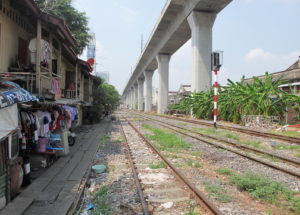
Squatter communities have sprouted up on land along many of Bangkok’s rail lines. Photo: Peter Janssen
“The story in the past was that each train station master had the title deeds, so when he retired some of them would take these title deeds with them, so the deeds are scattered around the country,” said Ruth Banomyong, head of the logistics and transport department at Thammasat University’s business school. “They have never centralized it.”
There are, however, low hanging fruits, especially in Bangkok, that could relatively easily be farmed out by a professionally-run SRT property company.
“I think the interest from the development community would be in the big projects they have – Makkasan and Bang Sue, those are the two biggies,” said Simon Landy, co-founder and advisor to Colliers Thailand, in regard to SRT’s two big land development projects planned in Bangkok.
Makkasan, a 497 rai (80 hectares) plot of land in the heart of central Bangkok, has been in the eyes of developers for years. “Makkasan is the main thing,” said Landy. “Because it’s in the middle of the city – 400 rai of undeveloped land right in the CBD (central business district).”
Some resettlement challenges are expected at Makkasan, about half of which is now occupied by a SRT workshop. “We will have to move [the workshop]. It’s more a problem with the people staying there,” Voravuth conceded. “They have lived there since their father’s generation. We have to talk to them nicely and get a new place.”
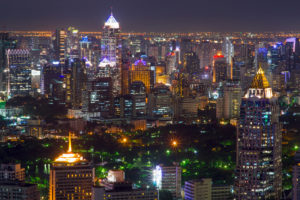
Another drawback to the SRT’s urban land holdings is that they can only be leased not sold. Under the SOE law governing the SRT, the enterprise is only permitted to lease land if it was acquired before 1997, a measure that prohibits SOEs and government agencies from buying land for anything other than public use.
Developing leasehold land is more difficult than freehold, given Thailand’s current 30-year limit on leases. “We cannot sell so it means that if you develop a condominium it has to be leasehold, not freehold. This is very difficult,” Voravuth said.
That’s another argument for allowing the proposed SRT property company to be professionally managed, with profits returning to the SRT to finance its huge pension fund and pay off debts. There are also hopes among developers that putting huge plots of SRT land on the market will put pressure on the government to amend the leasehold tenure from 30 to at least 50 years.
“This is very sensitive for certain conservative Thais but in the near future it will have to happen because in some areas there is no more private land,” said Vichai Viratkapan, acting director general of the Real Estate Information Center (REIC), a government office. “So, they will need longer term leases.”
Source: http://www.atimes.com/article/thai-state-railway-open-golden-empty-lands/


